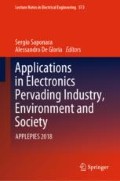Abstract
Ensemble Machine Learning (EML) consists of the combination of multiple Artificial Intelligence algorithms. This paper presents an efficient FPGA implementation of an Ensemble based on Long Short-Term Memory Networks (LSTM). For an efficient implementation, the proposed design uses the Partial Reconfiguration function available for FPGAs. Results are presented in terms of resources utilization, reconfiguration speed, power consumption and maximum clock frequency.
Access this chapter
Tax calculation will be finalised at checkout
Purchases are for personal use only
References
Lo Sciuto, G., Susi, G., Cammarata e, G., Capizzi, G.: A spiking neural network-based model for anaerobic digestion process. In: IEEE 23rd International Symposium on Power Electronics, Electrical Drives, Automation and Motion (SPEEDAM) (2016)
Brusca, S., Capizzi, G., Lo Sciuto e, G., Susi, G.: A new design methodology to predict wind farm energy production by means of a spiking neural network based-system. Int. J. Numer. Model. Electron. Netw. Devices Fields 7 (2017)
Scarpato, N., Pieroni, A., Di Nunzio, L., Fallucchi, F.: E-health-IoT universe: a review. Int. J. Adv. Sci. Eng. Inf. Technol. 7(6), 2328–2336 (2017)
Cardarilli, G.C., Cristini, A., Di Nunzio, L., Re, M., Salerno, M., Susi, G.: Spiking neural networks based on LIF with latency: simulation and synchronization effects. In: Asilomar Conference on Signals, Systems and Computers, pp. 1838–1842 (2013)
Khanal, G.M., Acciarito, S., Cardarilli, G.C., Chakraborty, A., Di Nunzio, L., Fazzolari, R., Cristini, A., Re, M., Susi, G.: Synaptic behaviour in ZnO-rGO composites thin film memristor. Electron. Lett. 53(5), 296–298 (2017)
Acciarito, S., Cardarilli, G.C., Cristini, A., Nunzio, L.D., Fazzolari, R., Khanal, G.M., Re, M., Susi, G.: Hardware design of LIF with Latency neuron model with memristive STDP synapses. Integr. VLSI J. 59, 81–89 (2017)
Khanal, G.M., Cardarilli, G., Chakraborty, A., Acciarito, S., Mulla, M.Y., Di Nunzio, L., Fazzolari, R., Re, M.: A ZnO-rGO composite thin film discrete memristor. IEEE, ICSE, art. no. 7573608, pp. 129–132 (2016)
Acciarito, S., Cristini, A., Di Nunzio, L., Khanal, G.M., Susi, G.: An a VLSI driving circuit for memristor-based STDP. PRIME 2016, art. no. 7519503 (2016)
Opitz, D.; Maclin, R.: Popular ensemble methods: an empirical study. J. Artif. Intell. Res. 11, 169–198
Polikar, R: Ensemble based systems in decision making. IEEE Circuits Syst. Mag. 6(3), 21–45
Rokach, L: Ensemble-based classifiers. Artif. Intell. Rev. 33(1–2), 1–39
Dalmasso, I., Galletti, I., Giuliano, R., Mazzenga, F.: WiMAX Networks for Emergency Management Based on UAVs. In: IEEE–AESS European Conference on Satellite Telecommunications. (IEEE ESTEL 2012), Rome, Italy, Oct. 2012, p. 1–6 (2010)
Giuliano, R., Mazzenga, F., Neri, A., Vegni, A.M.: Security access protocols in IoT capillary networks. IEEE Internet Things J. 4(3), 645–657 (2017)
Vivado Design Suite UG909 Partial Reconfiguration
Hochreiter, S., Schmidhuber, J.: Long: Short-Term Memory. Neural Comput. 9(8), 1735–1780 (1997)
Chang, A.X.M., Culurciello, E.: Hardware accelerators for recurrent neural networks on FPGA. In: 2017 IEEE International Symposium on Circuits and Systems (ISCAS)
Krstanovic, S., et al.: Ensembles of recurrent neural networks for robust time series forecasting. In: 2017 International Conference on Innovative Techniques and Applications of AI, Cambridge
Acknowledgements
The authors would like to thank Xilinx Inc, for providing FPGA hardware and software tools by Xilinx University Program.
Author information
Authors and Affiliations
Corresponding author
Editor information
Editors and Affiliations
Rights and permissions
Copyright information
© 2019 Springer Nature Switzerland AG
About this paper
Cite this paper
Cardarilli, G.C. et al. (2019). Efficient Ensemble Machine Learning Implementation on FPGA Using Partial Reconfiguration. In: Saponara, S., De Gloria, A. (eds) Applications in Electronics Pervading Industry, Environment and Society. ApplePies 2018. Lecture Notes in Electrical Engineering, vol 573. Springer, Cham. https://doi.org/10.1007/978-3-030-11973-7_29
Download citation
DOI: https://doi.org/10.1007/978-3-030-11973-7_29
Published:
Publisher Name: Springer, Cham
Print ISBN: 978-3-030-11972-0
Online ISBN: 978-3-030-11973-7
eBook Packages: EngineeringEngineering (R0)

